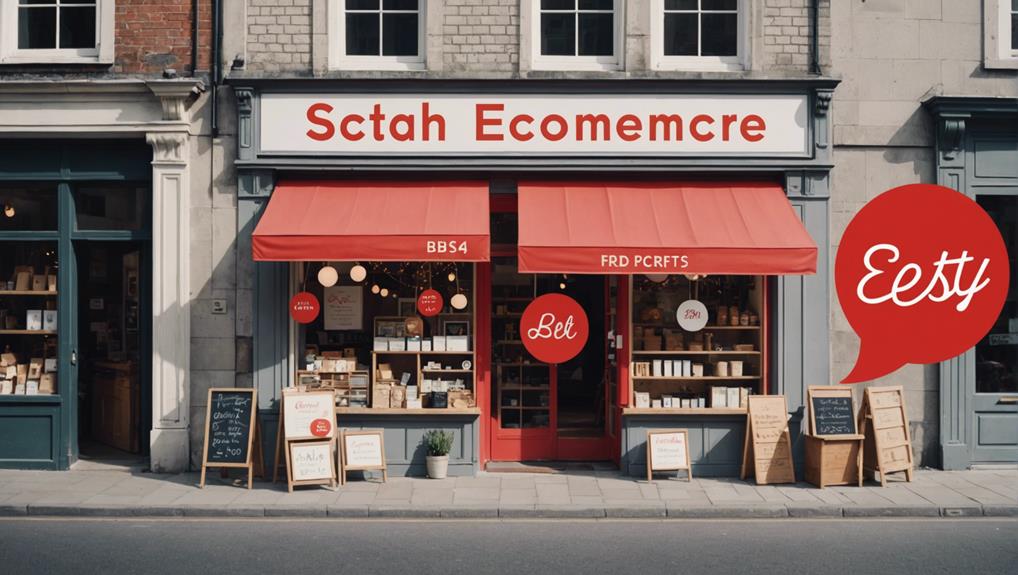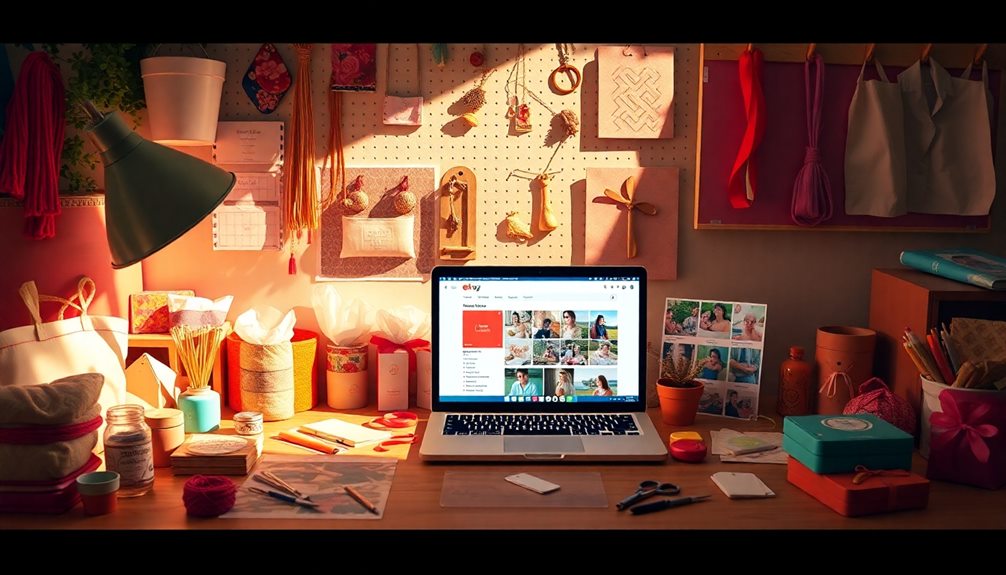When deciding between Redbubble and Etsy, you're choosing between two distinct e-commerce platforms that cater to different creative entrepreneurial needs. Redbubble focuses on print-on-demand products, handling production and shipping, with no listing or transaction fees, and limited customization options. Etsy specializes in handmade and vintage goods, allowing sellers to engage directly with customers, with more customization options, but charging a listing fee. Understanding your business priorities and goals is key to selecting the right platform for you. To find out which one suits you better, explore the features, fees, and selling processes of each platform to make an informed decision.
Key Takeaways
- Redbubble is ideal for artists focused on creation, offering print-on-demand products with streamlined production and shipping.
- Etsy is suited for sellers who want control over branding, customer service, and production, with a focus on handmade and vintage goods.
- Redbubble has no listing or transaction fees, allowing for customizable base prices and profit margins, whereas Etsy charges a $0.20 listing fee.
- Redbubble offers limited store customization options, whereas Etsy provides more flexibility and opportunities for unique brand identity.
- Determine your business priorities and goals to choose the platform that best aligns with your needs, considering factors like product types, fees, and customization options.
Understanding Redbubble and Etsy
When you're considering selling your art online, two platforms likely come to mind: Redbubble and Etsy, two distinct marketplaces that cater to different types of creators and shoppers.
Redbubble, founded in 2006, focuses on print-on-demand products, offering a vast array of items like clothing, stickers, home decor, and accessories. On the other hand, Etsy, established in 2005, specializes in handmade and vintage goods, showcasing unique, non-mass-produced items that highlight craftsmanship.
As an artist or seller, you'll notice the difference in the scale of creators on each platform. Redbubble boasts over 800,000 artists, while Etsy has a massive seller base of 7.3 million. Redbubble's print-on-demand model allows for a diverse range of artwork, whereas Etsy's emphasis on handmade and vintage items provides a more artisanal touch.
Another significant difference lies in the production and shipping process. Redbubble handles production, shipping, and customer service for artists, whereas Etsy allows sellers to engage directly with their consumers, offering a more personal storefront experience.
Features and Fees Comparison

Now that you've got a sense of the different marketplaces Redbubble and Etsy offer, it's time to crunch some numbers and compare the features and fees that'll affect your bottom line as a seller.
When it comes to fees, Redbubble and Etsy have distinct approaches. Redbubble has no listing or transaction fees, making it an attractive option for sellers who want to maximize their profit margins. On the other hand, Etsy charges a $0.20 listing fee per item, and also takes a transaction fee on sales.
Here's a breakdown of the key features and fees for each platform:
| Feature/Fee | Redbubble | Etsy |
|---|---|---|
| Listing Fees | None | $0.20 per item |
| Transaction Fees | None | Varies by sale |
| Payment Methods | PayPal, Direct Deposit | Various options through Etsy Payments |
| Customization Options | Limited | More control over pricing and payment frequencies |
| Payment Processing | Simple fee structure | More complex fee structure |
As you can see, Redbubble's fee structure is simpler and more straightforward, while Etsy offers more control over pricing and payment frequencies through Etsy Payments. Consider your profit margins and payment processing needs when deciding which platform is best for you.
Product Types and Selling Process

As you consider which platform is best for you, think about the types of products you want to sell and how you want to handle the selling process.
Redbubble specializes in print-on-demand products, where you design and they produce, while Etsy focuses on handmade, vintage, or custom items that you create and list yourself.
Understanding the differences in product types and selling processes will help you decide which platform aligns with your goals and preferences.
Types of Products
You'll find a distinct difference in the types of products offered on Redbubble versus Etsy, with the former focusing on print-on-demand items like clothing, stickers, and home decor, and the latter specializing in handmade, vintage, and custom goods.
As an artist or seller, you'll need to evaluate which platform aligns with your product offerings. On Redbubble, you can create unique designs and art on various print-on-demand products, from accessories to home decor. Your designs will be printed and shipped directly to customers, making it a hands-off selling process.
In contrast, Etsy is all about unique, handmade items that showcase artisanal craftsmanship. If you're skilled at creating custom products or one-of-a-kind goods, Etsy might be the better fit. The key is understanding the type of product you offer and choosing the platform that best supports your art and business goals.
Selling Process Steps
When it comes to selling on Redbubble versus Etsy, the process of getting your products to customers differs to a great extent, with Redbubble's print-on-demand model streamlining production and shipping, and Etsy requiring sellers to handle these tasks themselves.
As a seller, you'll follow different selling process steps on each platform.
On Redbubble, you'll:
- Upload designs to be printed on various products.
- Set prices for your designs, considering production costs.
- Earn profits from sales, with Redbubble handling printing and shipping.
- Focus on design and marketing, while Redbubble handles customer service.
In contrast, Etsy sellers are responsible for manufacturing, shipping processes, and handling printing and customer service themselves, giving them more direct control over their products and customer interactions.
While this requires more effort, it also allows for greater customization and personalization.
Understanding these differences in selling process steps can help you decide which platform is best for you.
Store Customization and Branding

By establishing a strong brand identity, you can differentiate yourself from competitors, and that's where store customization and branding come into play. When it comes to store customization and branding, Etsy offers more flexibility and opportunities for sellers. You can create a unique brand identity through Etsy's various branding opportunities, including an 'About Us' section that allows for storytelling.
In contrast, Redbubble's store customization options are limited, restricting you to basic profile and banner customizations. Additionally, Etsy allows for integrations with social media management tools and SEO optimization, giving you more control over your online presence. Redbubble, on the other hand, takes a streamlined approach, limiting third-party integrations for sellers.
If you want more flexibility in customizing your store and showcasing your brand, Etsy might be the better choice. However, if you prefer a more straightforward, hassle-free approach, Redbubble's simplicity might appeal to you. While Etsy offers numerous tools for personalization and control over your shop’s appearance, it also requires more hands-on management. This can be beneficial, especially if you’re looking to sell unique or handmade items like **topselling wood items on Etsy**, which often attract buyers seeking craftsmanship and authenticity. On the other hand, Redbubble allows you to focus more on your designs without worrying about the logistics of running a store, making it ideal for those who want to get their work out there with minimal effort.
Seller Fees and Profit Margins

As you consider the visual identity of your online store, it's equally important to think about the financial implications of selling on each platform, and that's where seller fees and profit margins come into play.
When it comes to seller fees, Redbubble and Etsy have different approaches. Here's a breakdown:
- 1. No listing or transaction fees on Redbubble, giving you full control over your profit margins.
- 2. Etsy charges a $0.20 listing fee per item, plus transaction fees, which can eat into your profits.
- 3. Customizable base prices on Redbubble let you set your desired profit margins, while Etsy's fees force you to adjust your prices accordingly.
- 4. Redbubble's fee structure is designed to help you maximize profits, whereas Etsy's fees can reduce your earnings.
With Redbubble, you have more control over your pricing and profit margins. You can set customizable base prices with markup percentages, allowing you to adjust prices based on your desired margins.
On Etsy, you'll need to factor in listing fees and transaction fees when setting prices, which can impact your profit margins. Consider these differences when deciding which platform is best for your online store.
Customer Service and Support

When assessing the pros and cons of Redbubble and Etsy, it's crucial to take into account the quality of customer service and support each platform offers.
You'll need to examine factors like the help and resource quality, response time and speed, and issue resolution rate to determine which platform aligns better with your needs.
Help and Resource Quality
When it comes to resolving issues or finding answers, you'll want to know that both Redbubble and Etsy prioritize customer satisfaction and offer resources to address your concerns promptly.
Here are some key highlights of their customer service support:
- Redbubble's Help Center: includes FAQs, order information, and artist resources for assistance.
- Etsy's Seller Handbook: provides seller support for shop management, listings, and technical issues.
- Redbubble's Email Support: offers customer service support via email, with an average response time of 24-48 hours.
- Etsy's Community Forums: allow you to connect with other sellers and get help from the community.
Both platforms understand the importance of customer satisfaction and provide resources to address seller concerns promptly.
Redbubble's email support and Etsy's Help Center are designed to provide you with the help you need, when you need it.
Whether you're an artist or seller, you can rest assured that both platforms have got you covered with their extensive customer service support.
Response Time and Speed
You'll likely want to know how quickly you can expect a response from Redbubble or Etsy when you need help, and fortunately, both platforms prioritize timely support.
When it comes to response time, Redbubble typically gets back to customer inquiries within 24-48 hours, while Etsy aims to respond to seller queries within 48-72 hours. This means that if you're an artist on Redbubble, you can expect a slightly faster response to your questions or concerns.
On the other hand, Etsy's longer response time might be due to its broader range of seller support channels, including email, live chat, and community forums. Redbubble, on the other hand, focuses more on artist support and provides customer support via email and a help center.
While Etsy's response time might be slightly longer, its multi-channel approach can be beneficial for sellers who prefer different communication methods. Ultimately, both platforms demonstrate a commitment to timely customer and seller support.
Issue Resolution Rate
With response times established, it's now important to evaluate how effectively Redbubble and Etsy resolve the issues that arise, which is critical in maintaining customer satisfaction and loyalty.
When it comes to issue resolution, both platforms prioritize customer satisfaction, providing assistance for any issues that may arise during the buying or selling process. Here's how they differ:
- Thorough support: Redbubble offers thorough customer service support, handling inquiries, refunds, and returns for artists and customers.
- Seller-managed support: Etsy allows sellers to directly manage customer service, including resolving issues, handling returns, and providing personalized support.
- Assistance with order tracking: Redbubble's customer service team assists with order tracking, product inquiries, and general support for a seamless shopping experience.
- Tailored solutions: Etsy sellers have more control over addressing customer issues, offering personalized solutions and direct communication channels.
In terms of issue resolution, both platforms have their strengths. Redbubble's thorough support ensures that customers receive timely assistance, while Etsy's seller-managed support allows for more personalized solutions. Ultimately, the choice between Redbubble and Etsy depends on your individual needs and preferences.
Choosing the Right Platform

Determine your business priorities and goals to decide whether Redbubble's print-on-demand model or Etsy's handmade focus is the best fit for your online marketplace venture.
When selling online, you need to evaluate priorities and goals to choose the right platform. If you prioritize creation over selling and want customizable profit margins per product, consider Redbubble. You'll have greater control over your profit margins, which can be attractive if you're an artist who wants to focus on creating unique art.
On the other hand, if you aim to sell handmade products for higher profit margins, opt for Etsy. Although Etsy requires more effort and control, you'll have greater control over branding and customer service. Redbubble attracts fewer buyers, but offers a more straightforward selling process for artists.
Weigh the pros and cons of each platform, considering your business strategy and goals. By choosing the right platform, you'll set yourself up for success in the competitive world of online marketplaces.
Frequently Asked Questions
What Is Better, Redbubble or Etsy?
You're wondering which is better, Redbubble or Etsy? It depends on you! If you're an artist seeking a hands-off approach with global reach, Redbubble might be the way to go, but if you value customization and unique creations, Etsy's your best bet.
Which Site Is Better Than Redbubble?
"When in Rome, do as the Romans do" – if you're looking for an alternative to Redbubble, consider Society6, which offers similar print-on-demand products with a more user-friendly interface and competitive commission rates, making it a strong contender.
Can You Sell on Both Etsy and Redbubble?
You can definitely sell on both Etsy and Redbubble, simultaneously leveraging each platform's strengths to reach a broader audience and maximize your online sales potential, without any restrictions.
Should I Sell on Redbubble or Etsy Reddit?
You're wondering whether to sell on Redbubble or Etsy, Reddit-style. Consider your product type: handmade and unique for Etsy, or print-on-demand for Redbubble.
Conclusion
In the end, Redbubble and Etsy are two distinct platforms catering to different creative entrepreneurs. Redbubble shines for artists and designers seeking a hassle-free, print-on-demand experience, while Etsy is ideal for makers and vintage sellers who crave control over production and shipping.
By understanding your business needs and weighing the pros and cons, you can choose the platform that aligns with your goals, ensuring a successful and fulfilling online venture.









